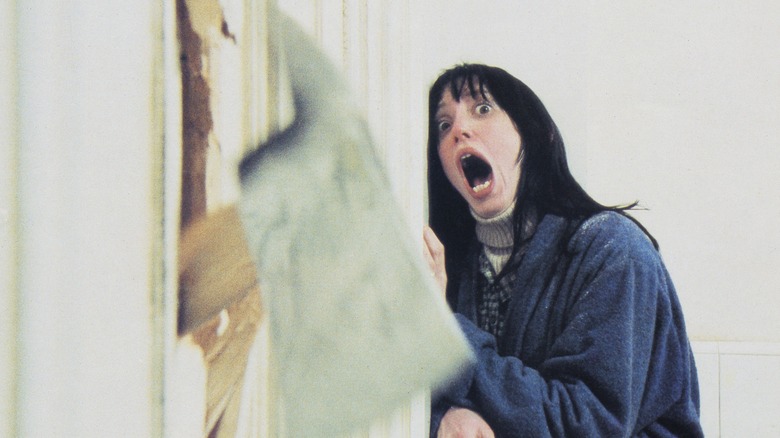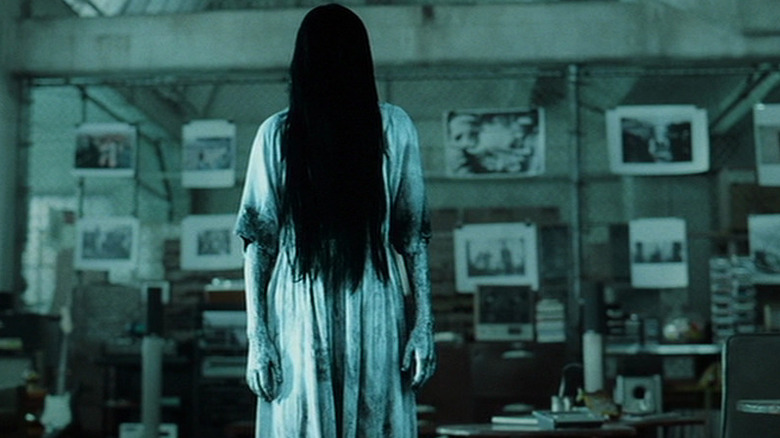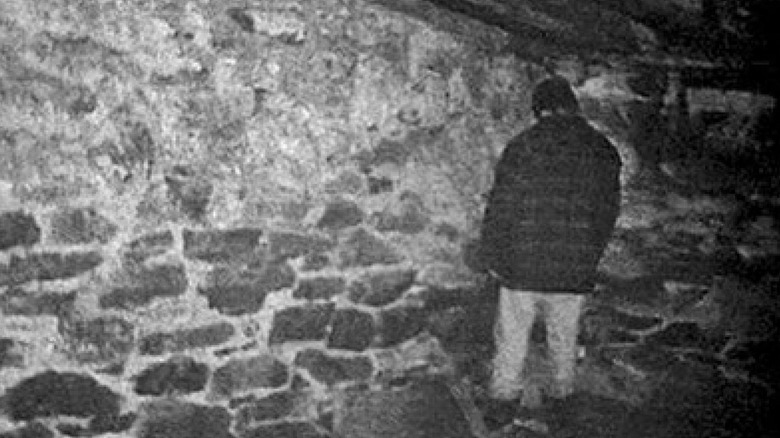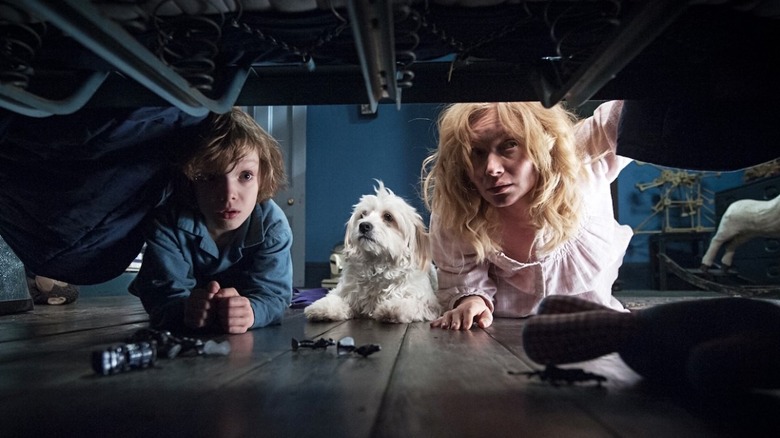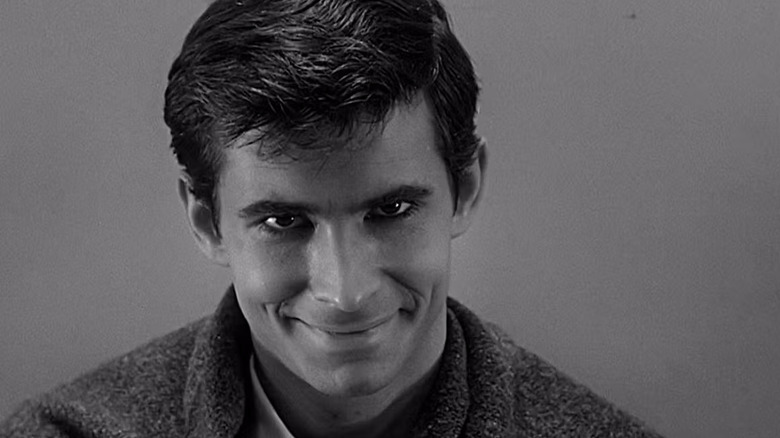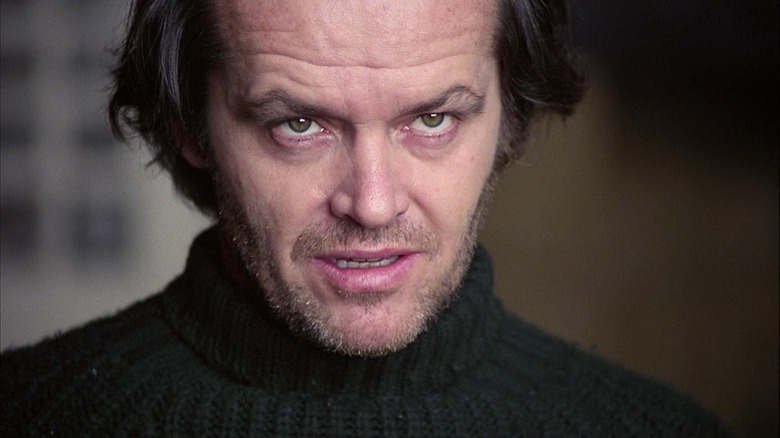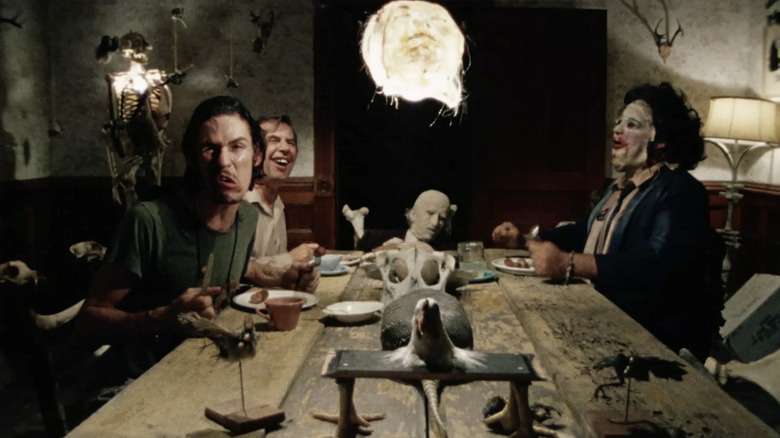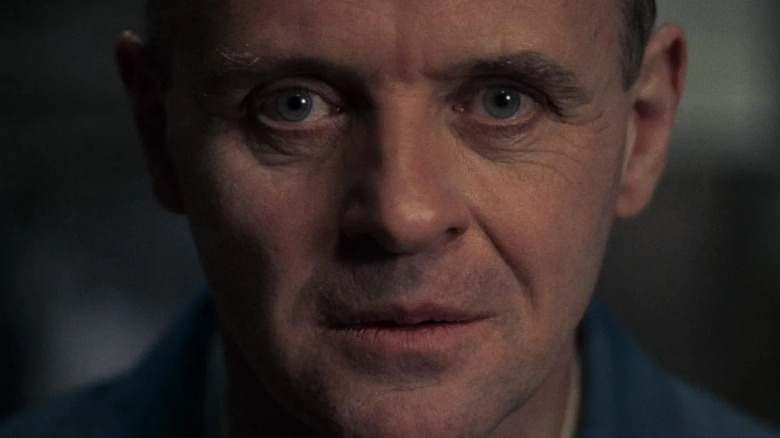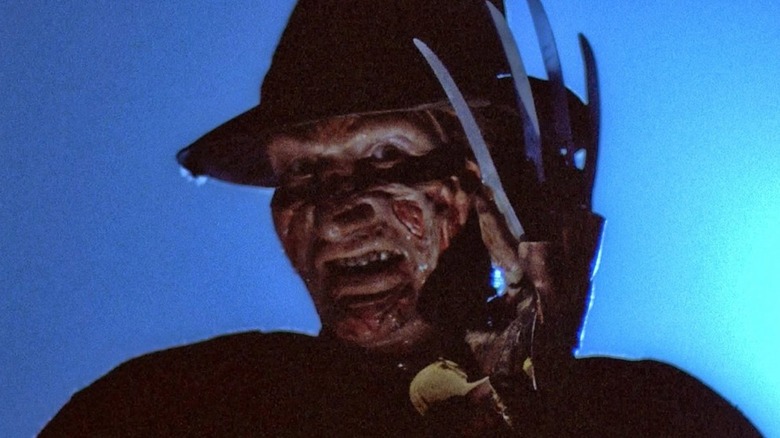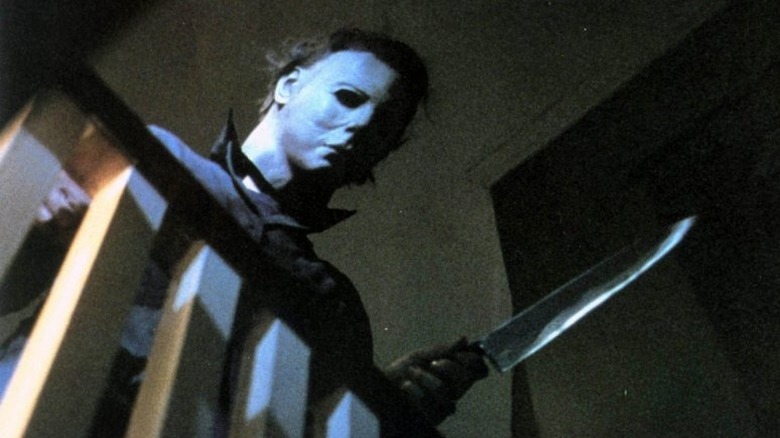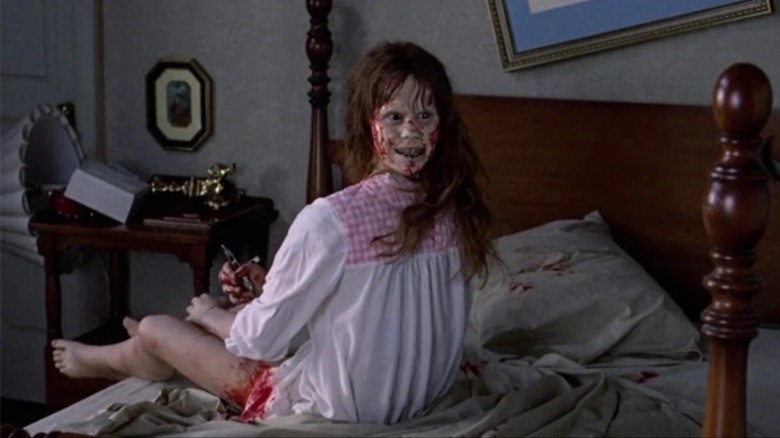The 10 Scariest Horror Movies Of All Time According To Artificial Intelligence
For nearly as long as movies have been entertaining audiences, horror movies have been there as an option for viewers feeling brave enough. More recently, however, the genre has exploded in popularity, offering viewers bold titles able to stand among some of the most entertaining flicks of all time. For horror veterans fans, it's more obvious than ever that beyond the visceral shock of gore and fear that horror provides, the best weave deeper themes and unsettling subtexts into their narratives.
While some audiences might not be able to get enough horror movies, the same can't always be said for critics. The genre is a notoriously hard sell at awards season, with only a handful earning Oscar nominations (and only one landing best picture). So, how do you build the perfect horror film? To get that answer, perhaps it's worth consulting — who else? — that unsettling, all-knowing entity known as artificial intelligence. Below, a breakdown of the 10 horror movies that ChatGPT says are the scariest of all time.
10. The Ring (2002)
Japanese audiences were terrified by 1998's "Ringu," itself an adaptation of a novel of the same name released earlier that decade. Just a few years later, the terrifying concept came stateside, becoming the phenomenon "The Ring."
The plot kicks off after journalist Rachel Keller (Naomi Watts), while investigating the inexplicable deaths of several local teenagers, falls into the same mysterious trap that took their lives. From there, she's left with no choice but to race against the clock to beat a cursed VHS tape, uncovering its dark, unsettling past.
The only film on this list to be granted a PG-13 rating over the more prevalent R, it serves as a reminder of just how horrifying "The Ring" was, without resorting to extreme gore or adult content. Though a case can be made for whether the original "Ringu" is better, artificial intelligence cites the latter as the scarier film. ChatGPT cited the film's pervasive haunting imagery, which comes in the form of both the deadly tape that plays throughout the film, as well as the appearance of its iconic villain, Samara.
Why did it choose "The Ring" over "Ringu?" When prompted, A.I. pointed to "The Ring" having a much more capable budget and overall stronger performances than its predecessor.
9. The Blair Witch Project (1999)
Nowadays, it's pretty hard to imagine heading to the theater or scrolling through your favorite streaming service and not being hit with a seemingly endless number of found footage horror flicks. But go back a couple decades ago, and the subgenre was just breaking through via a small, low-cost flick titled "The Blair Witch Project." Produced on a true shoestring budget (at least by modern filmmaking standards) of well under $1 million, the venture was a triumph of early internet marketing and withheld information, grossing several hundred times its production budget as many moviegoers went in thinking they were witnessing real found footage.
The eerie end product follows a group of film students who embark on a trip to uncover the truth of the titular urban legend. Said to be prowling around a sleepy Maryland town and the surrounding forest, the allure of the Blair Witch leads the amateur filmmakers to camp out in the woods in which she supposedly resides. If the grisly history of murders and supernatural sightings that plague the forest aren't bad enough, increasingly disturbing events make it clear that there may be more truth to the legend than fiction.
When A.I. was asked to weigh in on what makes "The Blair Witch Project" so terrifying even today, it focused on the film's flawless ability to build tension. Without any overt gore, and refraining from ever even showing the Blair Witch, audiences are left waiting for a release of tension that never quite comes.
8. The Babadook (2014)
Though Australian cinema can't compete with the industry juggernaut of Hollywood when it comes to sheer volume, when a movie does emerge from the land down under, it's often worth remembering. Franchises like "Mad Max" from director George Miller have been making waves with every release since 1979, and for horror fans, "The Babadook" achieved similar results.
The newest title on this list at less than a decade old, the film follows widowed mother Amelia (Essie Davis) struggling to raise her young son Samuel (Noah Wiseman). After she reads a terrifying children's book to him that features a monster known as "The Babadook," six-year-old Samuel becomes convinced the creature is stalking him in real life. Though she initially dismisses his fears as a child's overactive imagination run amok, it becomes increasingly clear that the Babadook may very well have departed the pages of the storybook for the real world.
Though there are plenty of reasons for "The Babadook" to make its way into discussions of all time great horror flicks, artificial intelligence specifically cited the film's striking cinematography, as well as its disturbing antagonist. A modern classic practically since release, it's safe to say this one will only find new fans in the future if A.I. has anything to say about it.
7. Psycho (1960)
Among the most respected and critically acclaimed filmmakers of all time, Alfred Hitchcock is nothing short of a legend. With an incredible directing career that originated in the silent era and would span more than half a century, the best works of the so-called "Master of Suspense" still hold their own against contemporary titles. While the British filmmaker often directed thrillers, such as "Rear Window" and "North by Northwest," he wasn't afraid to throw in horror elements from time to time, as evidenced by 1960's "Psycho," which would largely invent the modern slasher film.
The black-and-white title begins as something of a heist flick, as young lover Marion (Janet Leigh) absconds from her job with a small fortune. Though she hasn't yet been outed as the thief, her paranoid drive across state lines leads her to the infamous, out-of-the-way Bates Motel, where she spends her final fateful night. From there, the blood-spattered story of a deranged killer with a double identity has been terrifying audiences for decades, and bringing to life a number of sequels, a remake, and even a television series.
A persisting touchstone of pop culture, it shouldn't be much of a surprise to see "Psycho" on any list of horror greats. Artificial intelligence cites Anthony Perkins' performance as Norman Bates as the most crucial aspect of the film's horror, as well as a twist ending only Hitchcock could have executed so flawlessly.
6. The Shining (1980)
An author without equal, Stephen King has penned some of the most beloved — and feared — horror stories of all time. To those who aren't in the know, they might be shocked to find out just how many films (not even including non-horror like "Stand By Me" and "The Shawshank Redemption") have been the product of his unrivaled imagination. Among all time greats like "Carrie" and "It," it is 1980's "The Shining" that stands some 40 years later as one of the best adaptations of his work, even if he doesn't think so.
Set at the desolate yet sprawling Overlook Hotel, "The Shining" offers a terrifying vision from visionary filmmaker Stanley Kubrick. It follows writer and father Jack Torrance (Jack Nicholson), who takes a gig as caretaker at the property over the winter with his family in tow. It isn't until they arrive, however, that the hotel's troubling and murderous history is revealed. As the isolating cold drags on and cabin fever sets in, the horrifying apparitions of those who never left the property become more and more visible, all while Jack begins to succumb to the same insanity as those who came to the property before him.
Though it might seem unthinkable now, "The Shining" was derided by some critics upon release. Since then, however, it has gone on to be ranked among the all time horror greats, by both human audiences and their A.I. companions. Artificial intelligence pointed to the looming sense of dread that builds throughout "The Shining" as one of the most effective elements of fear in the film, and further stated that the mysterious nature of the film, as well as its many ambiguous elements, have kept viewers talking ever since its release.
5. The Texas Chain Saw Massacre (1974)
Though "Psycho" can be given the credit for laying the foundation of what audiences think of today when they hear the word "slasher," Tobe Hooper's original "Texas Chain Saw Massacre" deserves credit for transforming the genre into what it is today — packed with stomach-churning gore and guaranteed to keep audiences wincing throughout its runtime.
Released all the way back in 1974, the viewer gets a pretty accurate idea of what's going to go down in "The Texas Chainsaw Massacre" from the title alone. In what's now a common horror flicks touchstone, a trip through a barren stretch of road and subsequent car troubles leave a group of young adults stranded, with little choice but to seek refuge in a sketchy roadside home. What they don't know, of course, is that the home they've picked is filled with cannibalistic maniacs who have a love for chainsaws and wearing human flesh.
When artificial intelligence was asked why it ranked "The Texas Chainsaw Massacre" among some of the all time scariest horror flicks, it highlighted the fact that beyond the aforementioned gore, the film forced audiences to draw uncomfortable comparisons to many true crimes cases (most famously, Ed Gein) with which the nation had become all-too-familiar. It also credited the low production budget and gritty visuals as part of the film's staying power with audiences, making "The Texas Chainsaw Massacre" still feel raw and believable some 50 years later.
4. The Silence of the Lambs (1991)
Unlike most of the artificial intelligence-named titles, Jonathan Demme's phenomenon "The Silence of the Lambs" doesn't incorporate any supernatural elements to achieve its scares. Instead, it follows a high-stakes game of cat and mouse between FBI cadet Clarice Starling (Jodie Foster) and at-large serial killer Buffalo Bill (Ted Levine), with considerable, unsettling assistance from the deranged, cannibalistic Hannibal Lecter (Anthony Hopkins).
Part thriller, part outright horror flick, "The Silence of the Lambs" netted an impressive five wins at the 1992 Academy Awards, and has earned heaps of praise from critics and viewers in the decades since its theatrical release. But what specifically made A.I. select it as one of cinema's scariest entries? Most obviously, and perhaps most importantly, it cited the incredible performance by Anthony Hopkins as the complex serial killer, the most iconic role of a storied career.
Beyond that, artificial intelligence further credited things as straightforward as the film's visuals and lighting (perhaps best used in the final confrontation between Starling and Buffalo Bill), as well as its underlying exploration of the relationship between gender and power.
3. A Nightmare on Elm Street (1984)
Though plenty of classic horror films go back multiple decades, there's something special about the ones from the '80s. A boom of new ideas, some serious advancements in practical effects, and a pre-CGI industry meant that not only were freshly terrifying concepts being explored, but filmmakers were using creative, revolutionary methods to make them a reality. Among some of the decade's crowning achievements were the "Evil Dead" films, John Carpenter's "The Thing," and 1984's Wes Craven classic "A Nightmare on Elm Street."
Following four teenagers plagued by a rash of eerily similar nightmares — all involving a villain who would come to be known as Freddy Kruger — they could only find solace in the terrifying events being confined to their dreams. When the line between dreams and reality is blurred, all of their lives are in very real danger. From there, each one of them is locked in a battle against their own mind and body, desperately trying to solve the nightmarish mystery before exhaustion catches up with them and seals their fate.
Likely to blame for giving an entire generation of viewers sleepless nights, it's easy to see why many consider "A Nightmare on Elm Street" as one of the most terrifying films out there. Artificial intelligence agrees, not only crediting its disturbing practical effects and haunting villain for the film's success, but its ability to make viewers every bit as afraid to go to bed as the characters on screen.
2. Halloween (1978)
No list of horror greatness would be complete without John Carpenter; it's just a matter of which film will be chosen. One of his earliest directorial efforts, coming years before classics like "The Thing" and "They Live," "Halloween" was not just the first appearance of one of horror's most memorable baddies, but also a huge step forward for the slasher genre as a whole.
Set on the spookiest day of the year in a fictional midwestern town, the recently escaped and deranged killer Michael Myers is cutting and slashing his way through anyone in his path, and into the annals of horror movie history. From there, the series went off on a long, and admittedly pretty confusing path, with sequels and remakes galore. While it's a mixed bag in terms of quality across the 40-odd years of film releases bearing the "Halloween" name, none are comparable to the original.
There's no denying the lasting legacy "Halloween" has had on audiences everywhere, and A.I. certainly agrees. It goes on to cite aspects like the film's suburban setting as particularly effective in terrorizing the average viewer. Of course, Carpenter's talents as a filmmaker help elevate the title too, which artificial intelligence doesn't dismiss, specifically praising both his direction and shot framing as crucial elements of a rarely matched tale of suspense.
1. The Exorcist (1973)
For a movie often considered by human viewers as among the most terrifying of all time, it's not surprising to see AI agrees. This iconic William Friedkin title follows single mother and actress Chris MacNeil (Ellen Burstyn) and her 12-year-old daughter Regan (Linda Blair), who is beginning to act out in terrifying, inexplicable ways.
As Regan's symptoms worsen, and with nowhere to turn and conventional medicine having failed, a desperate Chris seeks the help of servants of God. While it soon becomes clear they're dealing with a genuine demonic possession, the path to save Regan is anything but easy.
Given how familiar horror fans are with "The Exorcist," both in terms of its premise and enduring impact on the wider art of film, what could artificial intelligence possibly have to add to the conversation? As it turns out, quite a bit. Beyond themes that may resonate deeper with the more religiously inclined, such as the battle between good and evil and the horrifying reality of coming face to face with a real demon, A.I. cited its claustrophobic setting, as well as the slow torture Chris is forced to endure, as crucial elements of why "The Exorcist" still remains terrifying to a modern audience.
